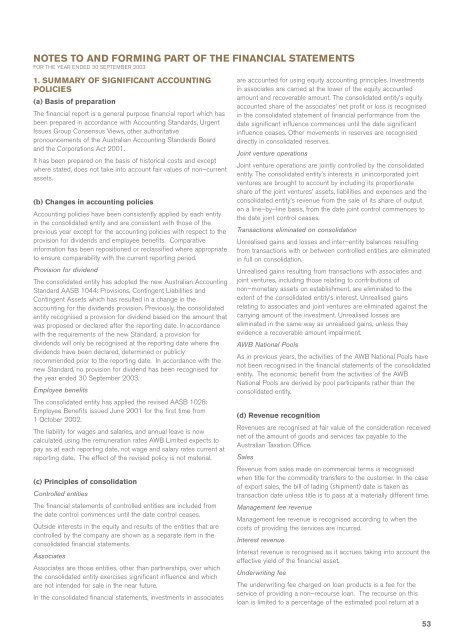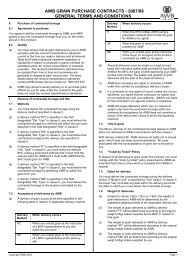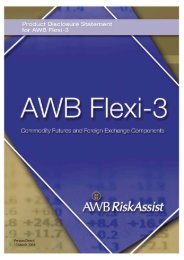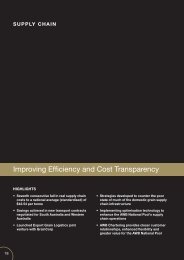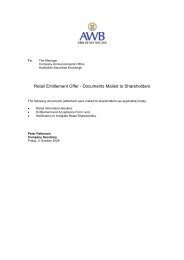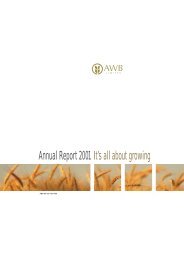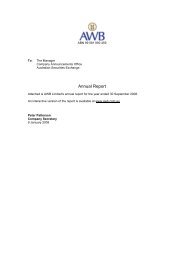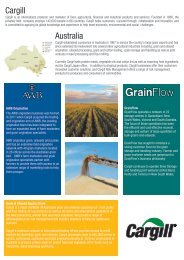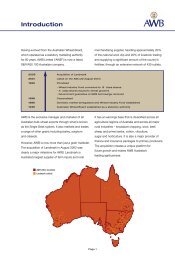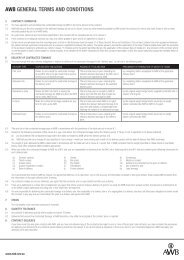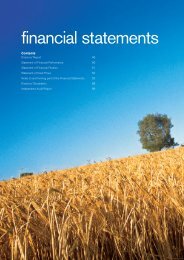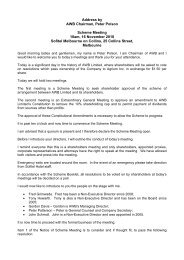AWB Limited - 2003 Annual Report
AWB Limited - 2003 Annual Report
AWB Limited - 2003 Annual Report
Create successful ePaper yourself
Turn your PDF publications into a flip-book with our unique Google optimized e-Paper software.
NOTES TO AND FORMING PART OF THE FINANCIAL STATEMENTS<br />
FOR THE YEAR ENDED 30 SEPTEMBER <strong>2003</strong><br />
1. SUMMARY OF SIGNIFICANT ACCOUNTING<br />
POLICIES<br />
(a) Basis of preparation<br />
The financial report is a general purpose financial report which has<br />
been prepared in accordance with Accounting Standards, Urgent<br />
Issues Group Consensus Views, other authoritative<br />
pronouncements of the Australian Accounting Standards Board<br />
and the Corporations Act 2001.<br />
It has been prepared on the basis of historical costs and except<br />
where stated, does not take into account fair values of non–current<br />
assets.<br />
(b) Changes in accounting policies<br />
Accounting policies have been consistently applied by each entity<br />
in the consolidated entity and are consistent with those of the<br />
previous year except for the accounting policies with respect to the<br />
provision for dividends and employee benefits. Comparative<br />
information has been repositioned or reclassified where appropriate<br />
to ensure comparability with the current reporting period.<br />
Provision for dividend<br />
The consolidated entity has adopted the new Australian Accounting<br />
Standard AASB 1044: Provisions, Contingent Liabilities and<br />
Contingent Assets which has resulted in a change in the<br />
accounting for the dividends provision. Previously, the consolidated<br />
entity recognised a provision for dividend based on the amount that<br />
was proposed or declared after the reporting date. In accordance<br />
with the requirements of the new Standard, a provision for<br />
dividends will only be recognised at the reporting date where the<br />
dividends have been declared, determined or publicly<br />
recommended prior to the reporting date. In accordance with the<br />
new Standard, no provision for dividend has been recognised for<br />
the year ended 30 September <strong>2003</strong>.<br />
Employee benefits<br />
The consolidated entity has applied the revised AASB 1028:<br />
Employee Benefits issued June 2001 for the first time from<br />
1 October 2002.<br />
The liability for wages and salaries, and annual leave is now<br />
calculated using the remuneration rates <strong>AWB</strong> <strong>Limited</strong> expects to<br />
pay as at each reporting date, not wage and salary rates current at<br />
reporting date. The effect of the revised policy is not material.<br />
(c) Principles of consolidation<br />
Controlled entities<br />
The financial statements of controlled entities are included from<br />
the date control commences until the date control ceases.<br />
Outside interests in the equity and results of the entities that are<br />
controlled by the company are shown as a separate item in the<br />
consolidated financial statements.<br />
Associates<br />
Associates are those entities, other than partnerships, over which<br />
the consolidated entity exercises significant influence and which<br />
are not intended for sale in the near future.<br />
In the consolidated financial statements, investments in associates<br />
are accounted for using equity accounting principles. Investments<br />
in associates are carried at the lower of the equity accounted<br />
amount and recoverable amount. The consolidated entity’s equity<br />
accounted share of the associates’ net profit or loss is recognised<br />
in the consolidated statement of financial performance from the<br />
date significant influence commences until the date significant<br />
influence ceases. Other movements in reserves are recognised<br />
directly in consolidated reserves.<br />
Joint venture operations<br />
Joint venture operations are jointly controlled by the consolidated<br />
entity. The consolidated entity’s interests in unincorporated joint<br />
ventures are brought to account by including its proportionate<br />
share of the joint ventures’ assets, liabilities and expenses and the<br />
consolidated entity’s revenue from the sale of its share of output<br />
on a line–by–line basis, from the date joint control commences to<br />
the date joint control ceases.<br />
Transactions eliminated on consolidation<br />
Unrealised gains and losses and inter–entity balances resulting<br />
from transactions with or between controlled entities are eliminated<br />
in full on consolidation.<br />
Unrealised gains resulting from transactions with associates and<br />
joint ventures, including those relating to contributions of<br />
non–monetary assets on establishment, are eliminated to the<br />
extent of the consolidated entity’s interest. Unrealised gains<br />
relating to associates and joint ventures are eliminated against the<br />
carrying amount of the investment. Unrealised losses are<br />
eliminated in the same way as unrealised gains, unless they<br />
evidence a recoverable amount impairment.<br />
<strong>AWB</strong> National Pools<br />
As in previous years, the activities of the <strong>AWB</strong> National Pools have<br />
not been recognised in the financial statements of the consolidated<br />
entity. The economic benefit from the activities of the <strong>AWB</strong><br />
National Pools are derived by pool participants rather than the<br />
consolidated entity.<br />
(d) Revenue recognition<br />
Revenues are recognised at fair value of the consideration received<br />
net of the amount of goods and services tax payable to the<br />
Australian Taxation Office.<br />
Sales<br />
Revenue from sales made on commercial terms is recognised<br />
when title for the commodity transfers to the customer. In the case<br />
of export sales, the bill of lading (shipment) date is taken as<br />
transaction date unless title is to pass at a materially different time.<br />
Management fee revenue<br />
Management fee revenue is recognised according to when the<br />
costs of providing the services are incurred.<br />
Interest revenue<br />
Interest revenue is recognised as it accrues taking into account the<br />
effective yield of the financial asset.<br />
Underwriting fee<br />
The underwriting fee charged on loan products is a fee for the<br />
service of providing a non–recourse loan. The recourse on this<br />
loan is limited to a percentage of the estimated pool return at a<br />
53


